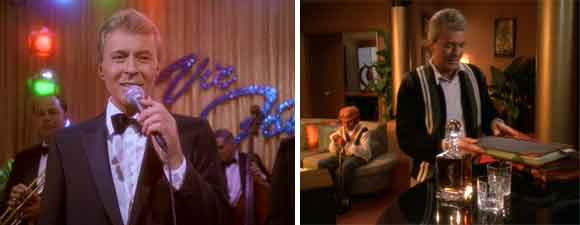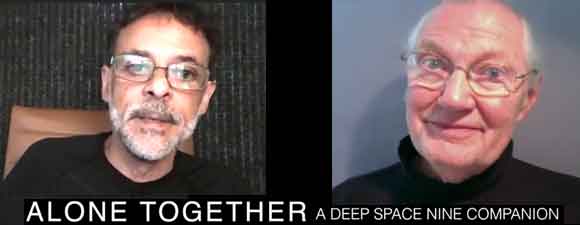Retro Review: The Search, Parts One and Two
10 min readSisko takes his crew on the Defiant to make peace with the leaders of the Dominion in the Gamma Quadrant, where Odo discovers his own origins.
Plot Summary: While Kira leads a discussion of scenarios for a Dominion attack, Sisko arrives on a cloaked Starfleet ship which he explains is a prototype to track down the Dominion’s Founders. Though their mission is meant to be peaceful, Starfleet wants them to show that the Defiant, designed to fight the Borg, will enable the Federation to defend itself from the Jem’Hadar. Sisko brings two guests: a Romulan named T’Rul, who will operate a loaned cloaking device, and a lieutenant commander named Eddington, who will be in charge of Starfleet security. Odo realizes that his own job managing station security has become superfluous, but Kira convinces him to travel to the Gamma Quadrant as a Bajoran liaison. Sisko also invites Quark, since he needs someone on board who has dealt with the Dominion’s trade representatives. Quark’s contact explains that a race called the Vorta manages all communications for the Dominion through a relay station on Callinon VII. While Quark goes off to oversee his trade deals, Sisko beams Dax and O’Brien to the remote relay station, where Dax finds that most of the outgoing transmissions are being sent to the Omarion Nebula, a region of space that inexplicably fascinates Odo. A surprise Jem’Hadar attack penetrates the Defiant’s cloak, forcing Sisko to abandon Dax and O’Brien. The Jem’Hadar pursue the Defiant and overwhelm the bridge crew. Kira and Odo attempt to fight them from engineering, but Kira is shot, waking to find herself on a shuttlecraft with Odo who has left the Defiant dead in space to seek answers in the Omarion Nebula. Kira demands that they go back to help Sisko and the others, but Odo insists on landing on a planet in the nebula, where a group of shapeshifters rises from a great pool to welcome Odo home.
While Odo begins to discover his people’s history of oppression and the Great Link that binds them, Kira tries to communicate with the Defiant. Sisko and Bashir have had to abandon the ship and are traveling back to DS9 on a shuttle when O’Brien and Dax rescue them, explaining that they were taken to the Founders and managed to persuade them that the Federation wants peace. Back on the station, Admiral Nechayev is in negotiations with Borath, a male of the same species as Eris. Borath explains that Eris did not admit to being a Founder because she feared for her life, but their people control the Dominion and are nearing a treaty with the Federation. T’Rul is furious that the Romulans have been excluded from the talks, which Borath claims is because they are disruptive, though the Cardassians have been invited, which seems odd to both Sisko and Garak. Fights break out between aggressive Jem’Hadar and Federation citizens, including O’Brien, who is injured. Sisko learns that the treaty will give the Dominion control of the Bajoran sector – including the station, the wormhole, and Bajor itself. While his crew is reassigned, Sisko forms an alliance with Garak and Dax to collapse the wormhole, keeping the Dominion in the Gamma Quadrant and protecting Bajor from being occupied by Jem’Hadar. Garak is killed during their attempt. Meanwhile, Kira finds Odo happy to be among his people and asks for his help contacting Sisko, which she is prevented from doing by a power source hidden behind a locked door. Puzzled why shapeshifters would need a door, Odo opens it and finds Sisko and the Defiant crew unconscious in biobeds. Borath, who is actually the Vorta monitoring them, explains that he has been running a simulation to learn how Starfleet will respond to attempts by the Dominion to gain a foothold in the Alpha Quadrant. As Sisko and the others wake, the female shapeshifter arrives and admits that her people are the Founders, seeking control over “solids” to protect their own interests. Disillusioned, Odo decides to go back to DS9 with his friends.
Analysis: I remember that I found “The Search, Part Two” so disappointing after “The Jem’Hadar” and “The Search, Part One” when they first aired that I wondered whether Star Trek would survive the end of The Next Generation. How wrong I was, and how much better the storyline seems in retrospect, though I still think the ending of the arc is a big betrayal in two ways: it pulls out the not unexpected but quite unforgivable “it was all a dream” twist, and it defers Odo’s confrontations both with his biological people and with his colleagues by playing the two conflicts against each other. It’s not clear at this point that the writers have any grand plan, nor that they’re capable of sustaining series-long arcs and long-term character development; at best, it seemed, we’d get a villain like the Borg who’d pop in occasionally but would largely remain out of sight and out of mind while the crew went about business as usual. Unimaginable, now, how the Klingons and Cardassians and Bajorans and Maquis and even the Enterprise crew would eventually play roles in the impending Dominion War, though we’re told from the start that this should be Starfleet’s major preoccupation for the next several years, that a Jem’Hadar assault could overwhelm the station’s defenses in two hours, leaving Bajor and the Federation open to attack. As if to prove their vulnerability, Sisko arrives and gives everyone a scare in the bad-ass Defiant, which never becomes as beloved as the Enterprise or Voyager – it’s always a supporting player to the space station – but acts as a game-changer, even if the cloak isn’t initially the salvation everyone’s expecting. New security officer Eddington acts as a game-changer as well, also in ways that are quite different than the initial suspicion that he’s mostly going to interfere with Odo’s job.
And we are introduced to a character who will become one of the most important in the series, though we never learn her name or even if she has a name. The female shapeshifter, the first person who ever speaks to Odo, at this point could turn out to be his mother or the Changeling Queen or simply the random individual who first realizes that one of their hundred offspring in the diaspora has come back to them. We learn some things about her almost immediately – that she distrusts solids, that she has concerns about Odo’s close relationship with Kira, that she is comfortable to the point of smugness in the role of teacher and mentor – but we don’t know whether these are personality traits or characteristics that Odo would find in any of the individuals who comprise the Great Link. Though Kira encourages Odo to show how glad he is to be there, the female shapeshifter isn’t overly demonstrative by humanoid standards either; if anything, she seems a bit impatient for Odo to get with the program so he can become a proper member of the Great Link, and it’s impossible to know at this stage whether that’s because the shapeshifters value every individual life (they do, as we will learn from the Vorta in The Ship) or whether they’re primarily hoping to absorb his knowledge of the Alpha Quadrant for strategic purposes. Both philosophy and practical questions like how long changelings live get put aside while Odo’s busy trying to learn to be a proper shapeshifter, to the point where it gets a bit campy as he turns into a bird (I always end up humming A Chorus Line: “Second week, more advanced, and we had to be a table, be a sports car, ice cream cone”). Before we have any reason to dislike or distrust his people as Founders, it’s frustrating to watch Odo being forced to conform in yet another situation where he feels he doesn’t fit in. It’s obvious that, to a novice, linking feels like a combination of great sex and an addictive drug, which the female shapeshifter is all too willing to use as a tool of manipulation.
“The Search” marks the moment at which Odo’s people even more than Kira’s become central to Deep Space Nine, and his role as a character changes accordingly. At the start of the two-part episode, he’s feeling pushed aside, useless, rejected: Starfleet doesn’t want him, Sisko wishes he’d be more of a team player, Quark treats him as an oddity, Kira’s support reminds him of all the ways he’s not like her. He’s humiliated that Kira has to trump up an invitation by the Bajoran government to get him on the mission to the Gamma Quadrant, embarrassed and angry when he has to share quarters with Quark and regenerate in front of the Ferengi. Then he sees an image of the Omarion Nebula and his universe gets larger. Genetic programming kicks in, though he doesn’t know that’s what it is; he just knows that he’s obsessed, drawn to the nebula like he’s never been drawn to anything else, stronger even than his sense of justice or duty. When he arrives, in the company of the most important person in his life, he finally knows where he comes from and that his exile was for a reason; he may never accept that that isolation was valuable for himself or for the Changelings, nor does he really understand why he is who he is yet, but it’s a tremendous evolution in a short time. It almost makes up for all the character growth by Sisko and Garak and the others that gets thrown away as a dream-memory when they learn they were under mind control in a fake battle for the Alpha Quadrant – at least one person has really, truly been changed by the arrival of the Dominion.
But about the dream-scenario, which the crew remembers as they come out of it, discussing where they thought they’d been a moment before: are we to believe that was driven by Founder technology, Vorta mental powers (which like telekinesis will cease to be a plot point), or a shared reality among the participants to which the Dominion does not have full access? I can’t imagine the Vorta know enough about the characters’ lives to include details like Sisko’s discussion with Jake about closed-door negotiations or the fact that Garak and Bashir regularly take meals together; those bits must have come directly from the minds of the participants. If the Founders have access to personal information at this level, I wonder why they don’t take advantage later of all the trivia they have amassed, when the Dominion takes over DS9. And I’d think they’d be itching to know more about Odo and how all these people feel about him, particularly other people’s impressions of his relationship with Kira. She’s very passionate on his behalf in both episodes of this two-parter, shouting at Sisko about Starfleet’s shunting him aside, pleading with him as a friend to stick around till he’s appreciated, swallowing her misgivings so that he can find happiness among his own people, holding his hand when he makes the choice to live as a solid. We still don’t know what kind of job Odo is going back to, since technically he’s been replaced as head of security and it’s hard to imagine he’ll want to take the sort of position he had among the Cardassians, dealing only with relatively minor squabbles on the station. It’s more frustrating that he leaves before he (or we) understand anything about how his people are meant to live, what they eat, how they reproduce, whether their own personalities strengthen or weaken during linking, what sort of bonds they form between individuals apart from the Great Link.
There’s lots of adventure and excitement, with most of the humor discarded when Quark departs in the first installment – new characters like T’Rul and Eddington who are likely to be recurring, lots of danger, lots of explosions and a new ship that’s practically destroyed before we get to know it. lots of tough decisions put on Sisko’s head. But we start to smell a rat long before the crew does – not only because Nechayev seems so out of character as a suck-up diplomat instead of an aggressive hawk, but because Garak’s death is so non-climatic and there’s no way the writers would destroy the wormhole (when it stops functioning a couple of seasons down the road, it’s an enormous shake-up signifying that the endgame is near). How fascinating that, since Garak isn’t actually there to contribute his own thoughts, some or all of the people in the dream simulation must believe him to be a hero! And dream scenario Eddington is a jerk, suggesting that some or all of them don’t trust him right from the start. No one in the simulation talks about the Prophets – Sisko isn’t quite ready to take on the mantle of the Emissary and Kira isn’t there to insist on continuing access to the Celestial Temple – but as Jake points out, Ben calls DS9 home and that’s not because he’s fallen in love with the “Cardassian monstrosity.” When he fights for the quadrant, it’s the Bajorans he insists on protecting, and when it comes to disobeying orders for that cause, he’s willing to go even further than he tolerated from the Maquis. Even without religious themes being mentioned, we can see how Sisko’s perspective is shifting from what’s good for Earth to what’s good for Bajor. Along with the Dominion War, that is this series’ other unforgettable arc, and I’m delighted it’s not neglected here in the uneven start to this new, post-Next Gen era.







On the issue of the revelation of it all being dream, I’m generally not a big fan since it deflates the whole story (Brian’s comments at the end of Family Guy episode “Lois Kills Stewie”). On a practical level, one still sees it coming with all too obvious clues. One is that we never see the outside of the station throughout Part 2. And two, even a government that is willing to pay any price to make peace with the Cardassians would not be foolish enough to appease the Dominion so quickly and easily. Even after all the buildup in “The Jem’Hadar” and “The Search, Part 1”, a lot about “The Search, Part 2” just seems to fall flat, especially with branching off into what seems at the start to be a completely unrelated subplot. At least the revelation that Odo’s race was the Founders saves it from being a total failure (as some observers have found the resolutions of Trek two-parters disappointing).
As usual, though, I enjoy the commentary of these episodes from the point-of-view of someone who has seen the series the whole way through where one can see subtle clues about character development later on down the road from Odo’s inner conflicts to Bashir’s having been genetically enhanced to how Sisko responds his role as Emissary.
Odd that this show doesn’t inspire the response the writers probably expected. The problem with reboots, i guess – they’re mreant for people who can’t stand the original but want to pretend that they did. ST XII please note
For me, the beauty of The search is the Odo/Kira/Founders A story. The B story is obvious, essential & trite